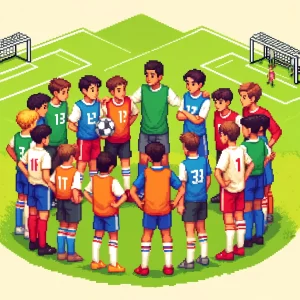
Who’s Heading the Ball Better?
Picture the exhilaration of a soccer game as the ball arcs high above, two players leap into the air, eyes locked on it. A powerful header can be the difference between a goal and a missed chance, and the skill behind this move has just taken center stage in a new study comparing heading techniques between men and women in the 2022 Men’s World Cup and 2023 Women’s World Cup. What they discovered could reshape the way we coach headers, making the game safer and potentially giving players an edge.
In this study, researchers analyzed hundreds of headers, attempted headers, and other head impacts from World Cup matches. They found that while men and women play the same sport, their heading techniques differ—often in ways that might affect both performance and safety. Let’s dive into the key findings and see how they could change soccer training for men and women alike.
Women and Men: Differences in Heading Techniques
First, let’s talk numbers. The researchers observed over 800 headers across men’s and women’s games, finding that both men and women had a similar number of head impacts per match, with an average of five headers per player in the men’s games and about 4.6 in the women’s games. But it wasn’t just about quantity; the way players performed these headers told an intriguing story.
When it comes to control, men were more likely to perform controlled headers, meaning they could accurately direct the ball as intended. About 83% of headers by men were controlled compared to 73% for women. This difference could be due to varying techniques in eye contact, head positioning, and upper body involvement.
For example, men used their upper bodies more during a header, stabilizing their position in the air and adding power to the motion. In fact, 88% of men’s headers engaged the upper body, compared to 80% for women. This upper body engagement helps players brace for impact and could prevent potential injuries from unstable collisions.
The Importance of Keeping Your Eyes Open
One of the more surprising discoveries involved eye closure. While players from both teams naturally blink before impact, women closed their eyes slightly earlier than men, at 1.91 frames versus 1.56 frames, respectively. While it seems like a small difference, in the fast-paced world of soccer, this fraction of a second matters. Closing your eyes earlier means you might miss the exact point of impact, which can make it harder to control the ball or even see a competitor coming into your space.
Keeping eyes open until the last possible second not only improves heading control but also reduces the chance of unintentional contact with other players. Some coaches already emphasize keeping the eyes open for longer as a “golden rule” in teaching proper heading, and these findings suggest it may be especially helpful for women to focus on this skill during training.
Forehead vs. Top of the Head: Why It Matters
Another technique-related difference: men were more likely to use their foreheads for headers, while women often used the tops of their heads. This might seem trivial, but it’s actually a big deal in heading performance. The forehead is the best place for ball contact because it allows for the most control and minimizes the force of impact on the skull.
Using the top of the head, in contrast, can lead to higher impact forces and less control over the ball’s direction. Coaches often teach young players to aim with their foreheads to achieve better results and minimize risk. So, if female players are more likely to rely on the top of their heads, this could be an important coaching point to address in training sessions.
Differences in Header Purpose: Passing vs. Interception
Why do players head the ball? In men’s games, headers were primarily used for passing, while women were more likely to head the ball to intercept play. This difference in purpose can influence how players approach headers and the skills they need to develop. Passing requires more precise control and direction, while interception calls for quick response time and body positioning to disrupt the other team’s play.
This focus on interception might explain why women in the study were less likely to perform controlled headers compared to men, as intercepting often requires a rapid reaction and doesn’t allow as much time for careful positioning.
Applications: What Coaches and Players Can Take Away
These findings highlight areas where coaches, trainers, and even players themselves can focus to improve heading performance, especially for female players. Here’s a look at how these insights can apply to different aspects of soccer:
Coaching
- Technique Training: Emphasize keeping the eyes open until the last possible moment and using the forehead for contact. Coaches can include drills that help players practice eye contact and forehead alignment to boost control and safety.
- Upper Body Engagement: Encourage players, especially female athletes, to engage their upper bodies during headers. Strengthening neck and shoulder muscles could also help improve upper body stability.
- Purpose-Based Drills: Tailor drills to develop passing accuracy for headers in addition to interception skills, giving players a well-rounded heading toolkit.
Player Development
- Building Confidence: Teach players how to head the ball with confidence by practicing these techniques in a controlled environment before applying them in-game.
- Eye Coordination Exercises: Introduce exercises that help players maintain visual contact with the ball to improve control and anticipate timing. Eye coordination drills can be particularly useful in game scenarios.
- Strength Training: Incorporate strength training for the neck and shoulders, which may help players withstand the impact of headers and reduce injury risk.
Club Management
- Injury Prevention: Understanding the technical aspects of heading can inform better safety protocols. Clubs can work with coaches to develop heading-specific warm-up routines and injury-prevention strategies.
- Customized Training Programs: With awareness of these differences, clubs can create programs that address the specific needs of male and female players. Incorporating video reviews of past headers can also help players learn from their own performances and improve over time.
Conclusion
As soccer evolves, so does our understanding of what it takes to perform at the top. This study has shown us that small differences—like eye closure timing, upper body use, and point of contact on the head—can have a big impact on both safety and effectiveness in soccer headers. For players, coaches, and clubs alike, focusing on these details can help shape stronger, safer athletes and unlock new possibilities in the game.
Step into the forefront of soccer innovation with ‘This Week in Soccer’.
Our newsletter is more than just words; it’s an interactive journey through the complexities of soccer analytics and strategy. Whether you’re a coach, educator, or enthusiast, our content is designed to spark curiosity and enhance your understanding. Subscribe today and be part of a community pushing the boundaries of soccer education.



